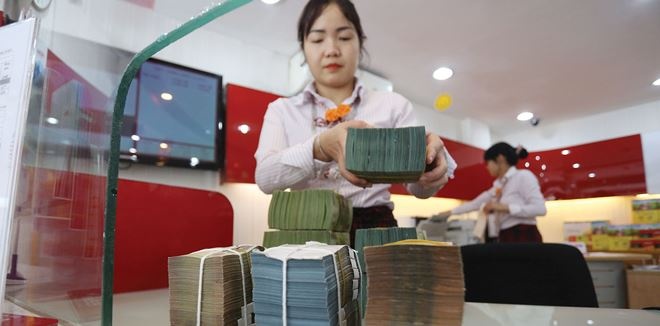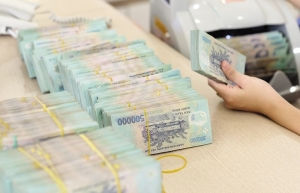Banks containing threats of bad debt
 |
Correspondingly, the NPL ratio over outstanding balances surged from 3.34 per cent early in the year to 4 per cent.
The bank has deducted $45.2 million to replenish its provisioning fund, thereby cushioning its pre-tax profit for 2023 to around $3.8 million, almost equal to the 2022 figure.
Meanwhile, the total NPL volume at Saigon Bank came to $17.04 million for 2023, nearly equal to the sum 12 months prior.
However, group 5 debts, which face being lost, accounted for 57 per cent of the total, reaching $9.78 million.
The bad debt ratio had slid slightly from 2.12 per cent at the start of 2023 to 2.03 per cent by the year-end.
| By the end of the third quarter last year, Vietcombank, VietinBank, and BIDV were among the five listed banks with the lowest NPL ratios. |
At BAC A BANK, the total bad debt volume had spiked 78 per cent compared to early year, reaching $38.6 million. Subprime and dubious (group 3 and group 4) debts all quadrupled compared to the start of 2023, pushing the NPL ratio over outstanding balances from 0.55 per cent to 0.92 per cent. The bank has one of the lowest bad debt ratios in the system.
Total bad debt volume at PGBank touched $38.2 million by the end of last year, surging 22 per cent compared to the start of 2023, in which subprime debts tripled, and dubious debts doubled, meanwhile group 5 debts diminished during the period.
Consequently, the bank’s bad debt ratio over outstanding balances remained unchanged compared to early year at 2.56 per cent.
The debt quality at tech-driven TPBank had retreated by the end of 2023, with the bank reporting $177.2 million in bad debt volume, nearly triple compared to early year.
The bad debt ratio then rose from 0.84 per cent to 2.05 per cent during the period.
Nguyen Thanh Tung, CEO of Vietcombank, revealed that by the end of last December, the bank’s debt quality had kept to the set target, with an NLP ratio of 0.97 per cent.
According to Vietcombank’s third-quarter 2023 financial report, its bad debt ratio had risen from 0.68 per cent by late 2022 to 1.21 per cent by the end of last year.
Another major state lender, VietinBank, saw a sharp drop in its bad debt volume in the fourth quarter of last year. The bank’s NPL ratio fell to just 1.12 per cent of total outstanding balances, compared to 1.37 per cent by the end of the third quarter of 2023 and 1.24 per cent in 2022.
Tran Binh Minh, VietinBank chairman, has stated that tackling bad debts is a crucial step in the banks’ restructuring process, especially as bad debts tend to soar when firms face myriad difficulties as they do today.
VietinBank has augmented its loan loss reserve, leaving the bank’s pre-tax profit after provisioning deduction to around $950 million, fulfilling the set target for 2023.
By the end of the third quarter last year, Vietcombank, VietinBank, and BIDV were among the five listed banks with the lowest NPL ratios.
 | Vigilance over bad debt essential As bad debts continue to pose a threat to the banking sector's performance, financial authorities are implementing a host of measures to keep tabs on credit quality and mitigate risk to optimise the efficiency of credit institution restructuring. |
 | Rising bad debt putting brakes on lending by financial firms The country is grappling with soaring bad debt and a surge in black credit, straining legitimate consumer finance firms and impacting vulnerable communities. |
 | Banks get go-ahead for capital increases Many banks in Vietnam have received approval for substantial capital hikes, signalling a strategic effort to fortify the financial sector and enhance several essential ratios. |
What the stars mean:
★ Poor ★ ★ Promising ★★★ Good ★★★★ Very good ★★★★★ Exceptional
Related Contents
Latest News
More News
- Tax sector wraps up 2025 and sets priorities for next year (December 25, 2025 | 14:00)
- A tipping point for digital and hybrid wealth management in Vietnam (December 23, 2025 | 13:33)
- $250 million deal targets women-owned SMEs, sustainable agriculture (December 22, 2025 | 17:40)
- Stock market posts resilient 2025 performance (December 19, 2025 | 18:17)
- Citi Vietnam receives 2025 AmCham CSR recognition (December 19, 2025 | 16:35)
- As global green supply chain reshapes, will Vietnam be left behind? (December 19, 2025 | 08:00)
- Banks gear up for massive capital increases (December 18, 2025 | 17:04)
- Securing capital and efficiency for Vietnam’s 2026-2030 growth ambitions (December 17, 2025 | 10:00)
- Energy sector in need of blended finance mechanisms (December 17, 2025 | 09:00)
- Vietnam still has room to mobilise capital for sustainable growth (December 17, 2025 | 08:57)

 Tag:
Tag:


























 Mobile Version
Mobile Version